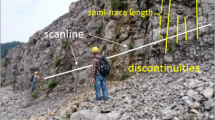Abstract
Strength of discontinuities with complex structure is an important topic in rock engineering. A large number of studies have shown that fractal is applicable in the description of this discontinuity. Using fractal interpolation method for the generation of rock joints, numerical experiments of shear tests of the jointed rock mass model were carried out using FLAC3D. The test results show that the real rock joints can be simulated by fractal curves obtained by fractal interpolation. The fractal dimension is an important factor for the characterization of jointed rock mass; test results show that the fractal dimension of rock joints can be related to the equivalent cohesion strength and shear strength of the rock mass. When the fractal dimension of the joint surface is less than critical dimension D c 1.404, the cohesion strength and shear strength of the rock mass increase as the fractal dimension increases; for larger fractal dimensions, all mechanical parameters decrease as the fractal dimension increases. Joint surfaces with different degrees of roughness were obtained by the fractal interpolation method. Three types of failure modes were observed in the tests: climbing slip failure, climbing gnawing fracture, and non-climbing gnawing fracture.
Similar content being viewed by others
References
ZHOU Yu, WU Shun-chuan, GAO Yong-tao, MISRA A. Macro and meso analysis of jointed rock mass triaxial compression test by using equivalent rock mass (ERM) technique [J]. Journal of Central South University, 2014, 21(3): 1125–1135.
POWER W L, TULLIS T E. Euclidean and fractal models for the description of rock surface roughness [J]. Journal of Geophysical Research: Solid Earth (1978–2012), 1991, 96(B1): 415–424.
RADLINSKI A P, RADLINSKA E Z, AGAMALIAN M, WIGNALL G D, LINDNER P, RANDL O G. Fractal geometry of rocks [J]. Physical Review Letters, 1999, 82(15): 3078–3081.
MANDELBROT B B. How long is the coast of Britain [J]. Science, 1967, 156(3775): 636–638.
XIE He-ping, CHEN Zhi-da. Fractal geometry and fracture of rock [J]. Acta Mech Sinica, 1988, 4(3): 255–264.
MILLER S M, MCWILLIAMS P C, KERKERING J C. Ambiguities in estimating fractal dimensions of rock fracture surfaces [C]// Proc 31st US Symp on Rock Mech. The Netherlands: AA Balkema Rotterdam, 1990.
DEN OUTER A, KAASHOEK J F, HACK H R. Difficulties with using continuous fractal theory for discontinuity surfaces [J]. International Journal of Rock Mechanics and Mining Sciences & Geomechanics Abstracts, 1995, 32(1): 3–9.
KEWEN L. Characterization of rock heterogeneity using fractal geometry [C]// SPE International Thermal Operations and Heavy Oil Symposium and Western Regional Meeting. Society of Petroleum Engineers, 2004.
TURK N, GREIG M J, DEARMAN W R, AMIN F F. Characterization of rock joint surfaces by fractal dimension [C]// The 28th US Symposium on Rock Mechanics (USRMS). American Rock Mechanics Association, 1987.
BOADU F K, LONG L T. The fractal character of fracture spacing and RQD [J]. International Journal of Rock Mechanics and Mining Sciences & Geomechanics Abstracts, 1994, 31(2): 127–134.
CARR J R, WARDNER J B. Rock mass classification using fractal dimension [C]// The 28th US Symposium on Rock Mechanics (USRMS). American Rock Mechanics Association, 1987.
AI T, ZHANG R, ZHOU H W, PEI J L. Box-counting methods to directly estimate the fractal dimension of a rock surface [J]. Applied Surface Science, 2014, 314: 610–621.
YANG Z Y, DI C C, LO S C. Two-dimensional Hurst index of joint surfaces [J]. Rock Mechanics and Rock Engineering, 2001, 34(4): 323–345.
KULATILAKE P H S W, BALASINGAM P, PARK J, MORGAN R. Natural rock joint roughness quantification through fractal techniques [J]. Geotechnical & Geological Engineering, 2006, 24(5): 1181–1202.
KULATILAKE P H S W, FIEDLER R, PANDA B B. Box fractal dimension as a measure of statistical homogeneity of jointed rock masses [J]. Engineering Geology, 1997, 48(3): 217–229.
XI Yue, CHEN Jin-jian, XU Yong-fu, CHU Fei-fei, LIU Chuan-xin. Yield stress of fractal aggregates [J]. Fractals, 2015, 23(03): 1550028.
LEE Y H, CARR J R, BARR D J, HAAS C J. The fractal dimension as a measure of the roughness of rock discontinuity profiles [J]. International Journal of Rock Mechanics and Mining Sciences & Geomechanics Abstracts, 1990, 27(6): 453–464.
XIE He-ping, WANG Jin-an, XIE Wei-hong. Fractal effects of surface roughness on the mechanical behavior of rock joints [J]. Chaos, Solitons & Fractals, 1997, 8(2): 221–252.
XIE H P, LIU J F, JU Y, LI J, XIE L. Z. Fractal property of spatial distribution of acoustic emissions during the failure process of bedded rock salt [J]. International Journal of Rock Mechanics and Mining Sciences, 2011, 48(8): 1344–1351.
YANG Lu-jun, ZOU Yan-ping, QIAN Jian-long. Application of fractal geometry in research of jointed rock mass [J]. China Water Transport, 2007, 5(8): 60–62. (in Chinese)
YANG Jie. Study on fractal interpolated and its fractal dimension [J]. Journal of Wuhan Polytechnic University, 2006, 25(1): 9–11. (in Chinese).
LI Shui-gen. Fractal [M]. Beijing: Higher Education Press, 2004: 236. (in Chinese)
WANG Wei, LI Liang-quan, XU Wei-ya, MENG Qing-xiang, LI Jun. Creep failure mode and criterion of Xiangjiaba sandstone [J]. Journal of Central South University, 2012, 19(12): 3572–3581.
NIKADAT N, FATEHI M, ABDOLLAHIPOUR A. Numerical modelling of stress analysis around rectangular tunnels with large discontinuities (fault) by a hybridized indirect BEM [J]. Journal of Central South University, 2015, 22(11): 4291–4299.
SUN Shu-wei, REN Hang, REN Lian-wei. Application of FLAC3D in geotechnical engineering [M]. Beijing: China Water & Power Press, 2011. (in Chinese)
LI Hai-bo, FENG Hai-peng, LIU Bo. Study on strength behaviors of rock joints under different shearing deformation velocities [J]. Chinese Journal of Rock Mechanics and Engineering, 2006, 25(12): 2435–2440. (in Chinese)
ZHOU Rui-guang. Mechanical effect of structural plane of rock mass [J]. Geotechnical Investigation & Surveying, 1981(1): 46–51. (in Chinese)
Author information
Authors and Affiliations
Corresponding author
Additional information
Foundation item: Projects(51479049, 51209075) supported by the National Natural Science Foundation of China
Rights and permissions
About this article
Cite this article
Yang, Ll., Xu, Wy., Meng, Qx. et al. Investigation on jointed rock strength based on fractal theory. J. Cent. South Univ. 24, 1619–1626 (2017). https://doi.org/10.1007/s11771-017-3567-9
Received:
Accepted:
Published:
Issue Date:
DOI: https://doi.org/10.1007/s11771-017-3567-9




